Myojin-ike Pond: The Quieter Side of Kamikochi
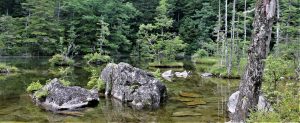
Kamikochi is one of Matsumoto’s worst-kept secrets. It’s actually not a secret at all. During the busy summer season busloads of visitors ascend to these highlands to take in the famed alpine scenery while escaping the heat and humidity enveloping much of Japan.
Not for nothing; it’s well worth the hour-long bus trip to see the pale sapphire waters of the Azusagawa River meandering through rich green forests of beech and pine, backed by the rocky 3,000-meter peaks of Mt. Hotaka as they pierce the cobalt sky.
The scenery is spectacular. But the place can get swamped.
Remedy this with some time and a pair of comfortable shoes.
In a previous post we explored the footpaths connecting Taisho Pond and Tashiro Pond with Kappabashi Bridge, Kamikochi’s de facto ground zero. For an alpine walk, this route is tough to beat.
But you can easily tackle it in the morning, leaving you all afternoon for the trip out to Myojin-ike Pond.
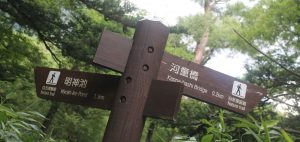
Kamikochi’s trails are superbly marked, with place names in English and distances between them clearly indicated. Trails run up both sides of the river, from either side of Kappabashi Bridge. Pick a side and head off. You can make your return on the opposite bank.
I’m partial to the trail on the left side of the river (going upstream) so let’s go that way.
One noticeable aspect of the 3.5-kilometer (2-mile) walk is the abundance of running water. This should come as little surprise in a narrow alpine valley, but that takes away nothing from the allure.
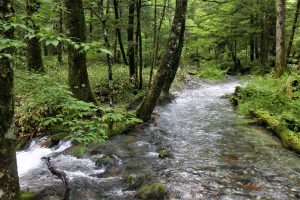
Another feature worth watching out for is the evidence of nurse logs, a colloquial term for a dead tree that has fallen become food for saplings that grow on top of it. The dead tree’s high nutrition content allows the young trees to grow at a much faster rate than trees growing out of the ground, allowing the new trees to grow roots that reach the soil well before the dead tree rots away. This is how trees like the one below come about.
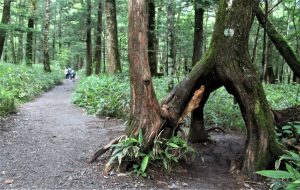
Also along this path lies Dakesawa Marsh, for some the most picturesque spot along the trail.
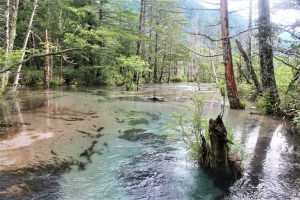
The trail to Myojin Pond consists of dirt path as well as wooden walkways, constructed to contribute to the conservation of the natural makeup of the valley.
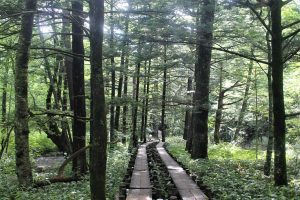
Like this path, Myojin-ike lies on the west side of the river, set back in the woods a couple hundred yards. There are clear signs here too, or you can look for the wooden torii gate marking the trail.
But wait! Aren’t these torii gates for shrines?
That’s correct! There is a shrine here, with some interesting history behind it.
According to legend, Hotakami-no-mikoto, son of Wadatsumi-no-kami, the god of the sea, and uncle of Jinmu, Japan’s first emperor, descended from heaven when the world was new and landed on top of Mt. Hotaka. This land is thus considered the sacred home of Hotaka-no-mikoto, the deity who protects these mountains and sits enshrined at Hotaka-Okumiya, in front of Myojin Pond.
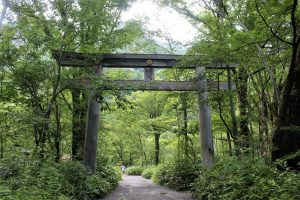
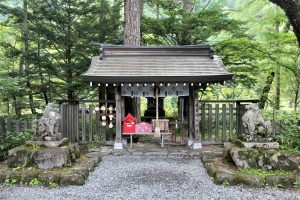
While roaming Kamikochi is free, the entrance to Myojin Pond is not. Fair warning for those not willing to spend a few hundred yen after all this walking!
The grounds of Myojin-ike contain two ponds (creatively named Pond One and Pond Two). This may be a misnomer as they seem to be one pond but who am I to argue with the son of the god of the sea?
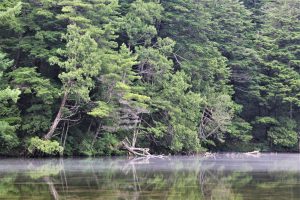
In contrast to the grandeur of the scenery around Kappabashi Bridge, the feeling here at Myojin-ike is decidedly intimate. Without the crowds at Kappabashi this place is also (usually) blessedly tranquil.
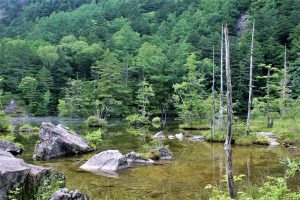
Your first view of Myojin-ike might include a small boat dock, likely with a long narrow boat or two tethered to its side. Unfortunately they are not for rent. Rather, they are used every year on October 8th during the Hotaka-Okumiya O-fune Matsuri, the boat festival held to pray for the safety of everyone in these mountains.
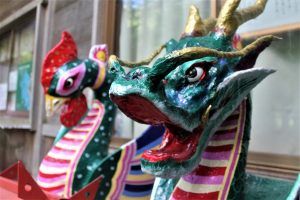
While there are overnight options up in Kamikochi – a campground and a very expensive hotel – the vast majority of visitors make a day trip of it. Catch the direct bus departing at 5:30am from the Matsumoto Bus Terminal, across the street from the train station in the Alpico Building. Alternatively there are several trains to Shin-shimashima Station, at the end of the Kamikochi Line; from there catch a bus up to Kamikochi. Check the Alpico website for times and ticketing information.